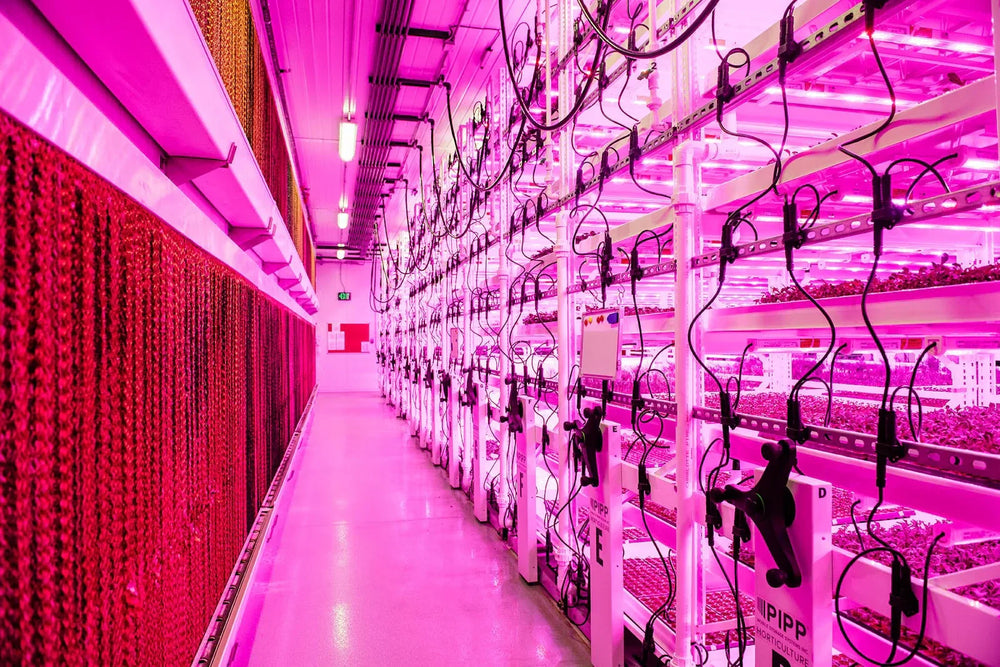
Ever wondered if plants need a good night’s sleep?
It so happens that yes, they kind of do. Like humans, plants have their internal cycles that influence their growth, relaxation, and flourishing. These are strongly linked with sunlight, reaching their zenith at dawn and slowing with sunset.
What about when the plants are indoors, removed from the sun?
At Planted Detroit, our LED farms mimic the sun's beat through meticulously designed light patterns, enabling plants to live their natural cycle in a completely indoor setting. It's part of a bigger movement—urban farming—that's revolutionizing how and where we produce food.
With vertical farming methods and hydroponic farming systems, we're not merely mimicking nature—we're transforming it.
The Science of Plant Sleep: Do They Really Rest?
Plants do not yawn or dream, but they sleep nonetheless. Through circadian rhythms—a built-in 24-hour clock—plants control their activity in terms of light and darkness.
Leaves close in, growth is reduced, and energy is redirected from photosynthesis to repair and respiration. Even certain plants drop their leaves slightly during the night in a process called nyctinasty.
These rhythms are not discretionary—they're necessary. Plants coordinate their biology with sunrise and sunset, controlling everything from flowering to pest response. Break the cycle, and you have stressed-out plants with stunted roots, poor nutrient uptake, and flavor that's flat.
Why Mimicking Nature Matters – Even Indoors
Even in the center of Detroit, away from natural light, light still dictates a plant's health. That's why LED farms like Planted Detroit don't simply inundate rooms with white light 24/7. We build full-spectrum lighting that recreates the changing colors and intensities of natural daylight, down to dawn break, high noon, and dusk.
This is not all for show. Light cycles affect how a plant behaves—from how efficiently it does photosynthesis to nutrient absorption and blooming. By respecting a plant's circadian rhythm, we don't merely grow faster—we grow more healthily.
Inside Planted Detroit’s LED Farms
In essence, an LED farm is an indoor, controlled setup in which crops are cultivated under artificial light rather than the sun. But this isn't a science experiment from some sci-fi novel. It's the future of agriculture, particularly in urban areas.
Within Planted Detroit's facility, rows of greens grow under tailored LED lights in layers utilizing vertical farming methods. This method enables us to produce more in a smaller area, without soil and any pesticides, greatly due to a clean, closed system.

How We Mimic the Sun with LEDs
So, how do you get a plant to feel like it's getting sunlight, no matter where you are, including a warehouse?
It's about timing and spectrum. Plants use various light waves for various activities—blue light for leafy growth and red for flowering and fruiting. By mixing up red, blue, and white LEDs, we create light recipes that activate the same biological reactions as natural light.
We also time our lights to dim and increase throughout the day, mimicking sunrise and sunset. This serves to regulate the internal clock of the plant to keep it in sync, even indoors.
As one of our growers puts it:
Light is a critical resource required by plants at nearly every stage of the life cycle.
Benefits of LED-Controlled Growth
LED-grown farming isn't only hip—it tastes better.
By providing plants with precisely what they require when they require it, we minimize stress and enhance flavor. Our greens turn a richer color, achieve improved nutrient density, and exhibit more uniform textures.
And since our crops are not subjected to volatile weather or insects, we eliminate the use of chemical sprays or preservatives. It's clean eating at its best.
Vertical Farming Meets LED Tech
In a place like Detroit, space is tight. That's where vertical farming excels.
Rather than spreading out across acres, we grow up, layering crops on top of each other in tall racks. This increases output per square foot and makes urban agriculture feasible in warehouse buildings and city blocks.
But vertical farming only succeeds if each layer receives equal attention. That's why our LED farms are designed for uniform light distribution, so each leaf on each level receives its fair share of light, nutrients, and love.
It's an intelligent solution for urban settings—and one that's already changing the future of urban farming.
Energy Efficiency & Sustainability
LED lights not only keep plants in good spirits but are also environmentally friendly. In comparison to old-style lighting, LEDs consume much less power and virtually no heat. That way, we can maintain the growing conditions consistently without shooting AC 24/7.
Our lighting systems are set up for efficiency, self-adjusting brightness, and spectrum during the day to save as little as possible. And with our operation contained, there's no light pollution to the surrounding neighborhoods.
It's innovation that honors its people—and the Earth.
Hydroponic Farming + LED Lights = A Perfect Match
Hydroponic agriculture bypasses soil altogether. Roots are grown instead in water with high levels of nutrients, constantly checked and balanced for pH and minerals. This approach saves as much as 90% more water than conventional farming.
And that's where LED farms truly excel. Since hydroponics is dependent on complete control of the environment, accurate lighting is paramount. LEDs enable us to calibrate growth cycles in a way soil farming could not, facilitating stronger roots, fuller leaves, and quicker harvests.
Cleaner, Faster, More Flavorful
Hydroponics + LEDs = clean, efficient, flavorful greens. No pests or soil-borne disease means no pesticides or rinsing. That makes our salads cleaner from the beginning and more nutrient-dense at the end.
Our growth cycles are quicker, too. In a conventional outdoor bed, you may have one or two harvests a season. In our hydroponic growing system, we harvest several times a month. That's more fresh greens, more frequently, and always at their best flavor.
Behind the Scenes: Plant Care at Planted Detroit
Each day at Planted Detroit begins with a check-in with the plants.
Growers make their way down each row, checking leaf health, tweaking light settings, and sampling water quality. Harvests occur on schedule, according to each crop's optimal time, not on some arbitrary calendar.
If the leaves of a plant are wilting or its hue is changing, we recognize it's time to adjust the spectrum or change the cycle. It's high-tech farming with hands-on attention—a union of data and instinct that keeps our farm healthy.
The Future of Farming Is Bright (Literally)
Farmland isn't growing along with the world's population. Future food demands can be met in a sustainable and scalable manner with LED farms, particularly in urban areas with limited space.
Leading this change in Michigan is something that Planted Detroit is proud to do. We're creating a new food system that is clean, local, and future-ready by fusing hydroponic farming, vertical farming, and smart LED technology.

Ready to experience the difference that smart farming delivers? Try our weekly salad packs or browse our colorful microgreens, produced in-house under precisely calibrated LED light.
Fresh, tasty, and pesticide-free—shipped right to your doorstep.
Want to get a glimpse of what goes on behind the scenes of a contemporary farm?
Check out our Instagram and TikTok @PlantedDetroit for a front-row look at our harvests, light experiments, and life within an LED farm. Post your salad creations on #GrownWithLight—please share your plate!
